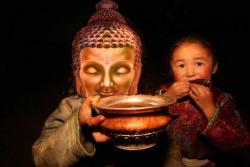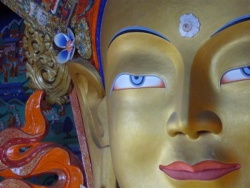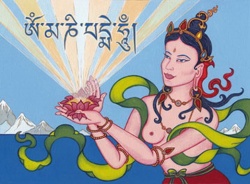Tao-an
Click here to see other articles relating to word Tao-an
Tao-an (312-385) was the first native Chinese Buddhist monk of major importance.
He inspired his disciples to seek the word of the Buddha in the best translations of texts from India and to interpret them in a critical, almost "scientific, " spirit.
Tao-an, whose family name was 'Wei', came from a traditionally Confucian family who lived in what is now southern Hopei Province.
He was born in a period of constant bloody warfare and seems to have been orphaned at an early age.
He became a Buddhist novice at the age of 11, slowly distinguishing himself by his phenomenal intelligence, although his appearance was extremely unprepossessing.
As was the custom, he left his monastery after ordination to wander from place to place seeking instruction from different masters, studying sometime after 335 with Fo-t'u-teng in 'Yeh' (northern Honan).
Tao-an soon led his own disciples in various monasteries in the North, being joined by his most famous disciple, Hui-yüan, on 'Mt. Heng' in northern Shansi in 354.
During this period (until 365) Tao-an was, since he came from a scholarly family,
exposed to the prevailing theories of metaphysical Taoism (hsüan-hsüeh) based mainly on the commentaries by 'Wang Pi' (226-249) upon the Tao-te ching and by Kuo Hsiang (died 312) upon the Chuang-tzu.
After joining the Buddhist sangha, he read widely in early translations of texts on dhyana (meditation) and perhaps on Prajnaparamita philosophy.
He then began his bibliographical and exegetical work, being the first Chinese to make sentence-by-sentence commentaries on Buddhist works, commentaries that attempted to understand what the text really meant.
In 365 Tao-an fled the chaos that incessant warfare among barbarian dynasties had made of North China and settled in Hsiang-yang (northern Hupei) with 400 or 500 disciples.
Because the Pai-ma monastery was too small, he soon moved to the T'an-hsi monastery, a private mansion. Here Tao-an reached his maturity as philosopher, scholar, and religious leader.
Tao-an's Teachings
Tao-an's philosophy is known as the theory of Penwu, which may be translated as "Fundamental non-differentiation, " and which attempts to interpret the Buddhist idea of sunya (emptiness) in terms reminiscent of Wang Pi.
The differentiated world as we know it is based upon a substratum of 'wu' (basic non-differentiation).
It is only by realizing, through meditation, the basic oneness of this substratum that we can shake off the impediments of the mundane world and arrive at truth and salvation.
Tao-an's scholarship at this period is represented by his analytical bibliography of over 600 Buddhist works called Tsung-li chung-ching mu-lu and finished in 374, a truly revolutionary work that set the pattern for all later Buddhist bibliographies.
His religious development was especially noteworthy for his devotion to the worship of Maitreya, which he seems to have originated in China, and for his unceasing study of the rules of monastic life (Vinaya).
He also originated the practice of giving monks the surname "Shih, " underlining the fact that they are sons of Buddha Sakyamuni is Shih-chia-mu-ni in Chinese).
When, in 379, Fu P'i captured Hsiang-yang, Tao-an followed him to the Former Ch'in capital, Ch'ang-an, after having sent most of his disciples away to form their own centers. In the capital he was extremely active in secular as well as in Buddhist cultural life,
and very close to Fu Chien, the reigning emperor, and to the center of political power.
Tao-an devoted himself chiefly to the supervision of the translation of new materials from India and central Asia;
in 382 he laid down a series of principles that were used by translators long afterward, although he himself knew no Sanskrit.
These new translations were of enormous importance for the understanding of the true meaning of Buddhist texts.
Toward the very end of his life, Tao-an felt overwhelmed by the feeling that he could no longer assimilate this obviously more profound understanding of the Buddhist message.
This feeling was typical of him, of his conscientiousness, his humility, and his intellectual honesty, making him the most important figure in early Chinese Buddhism, before he was overshadowed by his disciple Hui-Yüan and by Kumarajiva, who was brought to China through Tao-an's influence.




